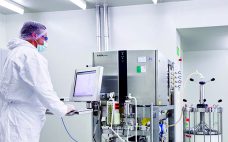Freeze–thaw processes affect the quality of biopharmaceutical proteins (1–13) and human cells (14). It has been reported that no method consistently controls freezing and thawing rates for biological formulations (1). My recent study refutes that claim with validated rate-controlled freezing and thawing of such formulations in 16-L single-use bags (15). The study reported herein presents a consistent method for controlled-rate freezing and thawing of bottled formulations. It also highlights the effect of load and container position on freeze rates. The…
2016
Collaboration Is Key to Innovation in Biotechnology
A new report from Thomson Reuters shows that innovation in biotechnology declined slightly in 2015, and biotech is the only one of a dozen worldwide industries examined to show that kind of decline (1). To measure innovation, compilers used metrics such as patents filed and scientific literature cited. Looking at the details, however, the dip was just a 2% drop from 42,584 events in 2014 to 41,624 in 2015. The same dynamics had revealed a 7% increase in innovation from…
Ask the Expert: Christoph Herwig on Acceleration of Bioprocess Development Using DoE and Physiological Control
Acceleration of Bioprocess Development Using DoE and Physiological Control with Christoph Herwig Understanding the interdependencies among process variables, product quality attributes, and process parameters is key to achieving quality by design (QbD). Developers need to gather as much meaningful information as possible from their experiments. In a BPI “Ask the Expert” webinar on 7 August 2016, Professor Christoph Herwig of the Vienna University of Technology demonstrated how experiments based on physiological key parameters can be linked to design of experiment…
Ask the Expert: Ryan Boniface on Modification of Glycans in Bioprocessing
Modification of Glycans in Bioprocessing with Ryan Boniface Protein quality determines clinical behavior. Glycosylation is a key product quality attribute for many biotherapeutic proteins expressed by mammalian cells. N-linked glycans can display macro- and microheterogeneity with a degree of variation that depends on several factors. It’s often challenging to predict, achieve, and maintain preferred glycosylation profiles. For an “Ask the Expert” webinar on 15 June 2016, bioproduction scientist Ryan Boniface of Thermo Fisher Scientific explored approaches to modifying glycan patterns.…
Addressing the Challenges of Developing Biopharmaceutical Drugs
The biopharmaceutical industry is enjoying considerable success. Its products account for about a fifth of world pharmaceutical revenues, which are growing at twice the pace of those generated by most traditional chemically synthesized drugs. Biopharmaceuticals populate the list of best-selling drugs, and a number have achieved blockbuster status. Biotechnology stocks have outperformed the general market as investment has flowed into the industry. As with other highly profitable markets, the market for biopharmaceuticals has become increasingly competitive. Reflecting this fact, in…
September Supplement From the Editor
When it comes to outsourcing, I sometimes worry that most of what can be said already has been. How many times do we need to focus on communication issues, which are still an essential element behind successful contract services relationships? As with so many subjects we cover, familiar outsourcing terminology can lead to the false assumption that an industry segment or technical process is pretty much the same as always. After all, speed and efficiency and cost-effectiveness have been goals…
Biopharmaceutical Contract Manufacturing Technology and Capacity Investments
The market for biopharmaceutical contract manufacturing has shown robust growth over the past few years. The continuing growth of biopharmaceuticals and the increase in new and novel drug projects entering clinical pipelines are fueling the market’s double-digit growth rate. Responding to these new demands, contract manufacturing organizations (CMOs) are expanding both their capabilities and capacities. Background Information presented here draws from recent interviews with six executives at biopharmaceutical contract manufacturing organizations, and from HighTech Business Decisions’ latest report, Biopharmaceutical Contract…
The Virtual Pharmaceutical Company: A New Pathway to Market?
In our modern biopharmaceutical industry, the maxim “bigger is always better” no longer applies. The industry’s modest virtual model persists in its popularity, emerging as a contemporary method of workplace efficiency. With an absence of manufacturing, virtual biopharmaceutical companies have found themselves unburdened by the multiple layers of bureaucracy that often plague large companies. With such freedom, they have operated much more efficiently in terms of time, resources, product specialization, and finances. As a result, virtual biopharmaceutical companies are growing…
Outsourcing and Biomanufacturing Challenges for Emerging Therapies: A Roundtable Discussion at BIO 2016’s BPI Theater
The biopharmaceutical industry is increasingly interested in a range of emerging therapies. “We’re really starting to get beyond the monoclonal antibody,” said Patricia Seymour (senior consultant with BioProcess Technology Consultants) in her introduction to a lunchtime BPI Theater roundtable at the 2016 Biotechnology Industry Organization annual convention in San Francisco, CA, this past June. The discussion brought together three industry insiders for strategic outsourcing to talk about emerging biotherapies and their manufacturing challenges: Mark Angelino (senior vice president of pharmaceutical…
Managing Customer and Regulatory Expectations
Partnering with a contract development and manufacturing organization (CDMO) allows drug-product sponsors to turn fixed costs into variable costs. Market forecasting by pharmaceutical companies drives numerous decisions in development programs: sales-force resources, geographic resource distribution, and (of course) manufacturing planning. It is a widely accepted fact in the pharmaceutical industry that accurate forecasting is a challenge, especially for new drug launches. A number of models can be used to develop drug forecasts, but none of these models is perfect. No…







